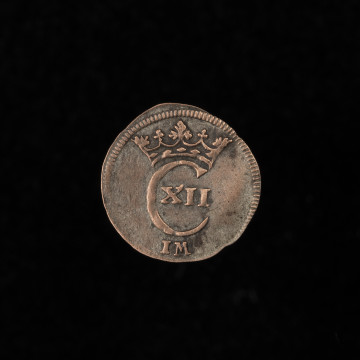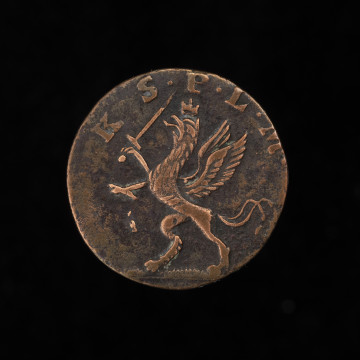
Witen
1707
National Museum in Szczecin
Part of the collection: Pomeranian coins
Double schillings are one of the most recognizable Pomeranian coins. They were minted en masse by the Griffins to the same iconographic scheme, i.e. the griffin on the obverse and the DS monogram (Doppelschilling) on the reverse. The issue of these denominations was resumed in 1656, during the reign of King Charles X Gustav (1654–1660). They resemble the coins from the ducal times, which was to facilitate their circulation on the market. Around mid-17th century, the mint in Szczecin was managed by Ulryk Bütkow, an experienced mintmaster and the mints' tenant, who had previously organized coinage for Bogislaw XIV at Koszalin mint (1631–1637). With regard to the mintage from the times of Charles X Gustav, the written sources are scarce. However, it is known that due to the rising price of silver during the Swedish Deluge, silver issues were limited to full-value orts and thalers and low-quality double shillings and wittens. An interesting fact is the discovery of the griffin punch, DS ligature and rosette on the said coins by the excellent Szczecin goldsmith and medallist Gottfried Tabbert (prior to 1618–1664). In the ducal period, Tabbert was the author of many exceptionally beautiful coins, including commemorative coins for the ceremonial funeral of the last Pomeranian duke, Bogislaw XIV, in 1654. Not all coins were signed, but comparative studies of stamps allow to associate some of them with Tabbert. Genowefa Horoszko
Author / creator
Object type
schilling
Technique
coining
Material
silver
Origin / acquisition method
acquisition
Creation time / dating
Creation / finding place
Owner
Muzeum Narodowe w Szczecinie
Identification number
Location / status

1707
National Museum in Szczecin

1916 — 1918
National Museum in Szczecin

1792
National Museum in Szczecin
DISCOVER this TOPIC
National Museum in Lublin
DISCOVER this PATH
Educational path